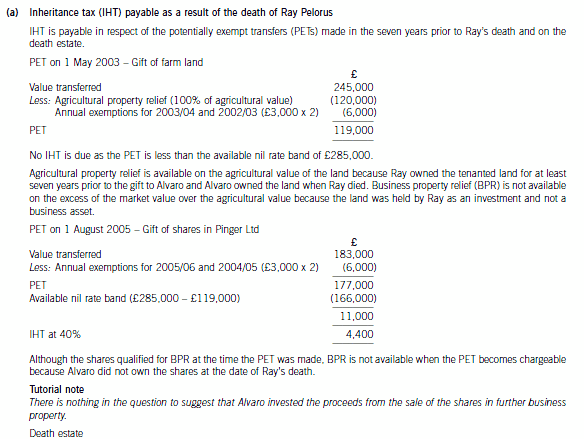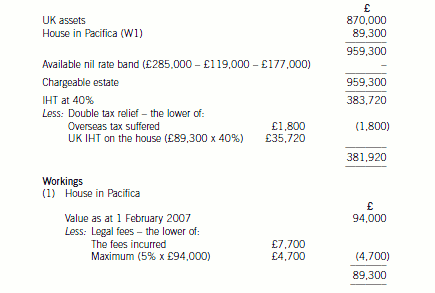须知!ACCA考试顺序都有哪些要求?
发布时间:2020-02-01
你知道ACCA考试顺序都有哪些要求?不知道的小伙伴赶紧跟着51题库考试学习网一起来了解一下吧!
ACCA总共有15门考试科目,其中13门是必考。在这些科目当中,又可以按照难易程度分为三个不同的阶段。那么,在这些课程当中,有没有报考顺序的要求呢?可以随便选择吗?今天就应广大学子的要求,来给大家一一解答这类问题。
首先我们来说说ACCA规定的大的方向的考试顺序是怎么样的。ACCA考试必须按照模块顺序来进行,即知识模块-技能模块-核心模块-选修模块。必须按照这个顺序来报考,但是各个模块内部的科目是可以打乱顺序考的。当然,这15个科目的考试顺序也是有规定的。15科目分为四个大模块:知识模块(AB-FA)、技能模块(LW-FM)、核心模块(SBL&SBR)、选修模块考试必须按照模块顺序来进行,即知识模块-技能模块-核心模块-选修模块。必须按照这个顺序来报考,但是各个模块内部的科目是可以打乱顺序考的。
ACCA在国内称为"国际注册会计师",实际上是英国的注册会计师协会之一(英国有多家注册会计师协会),但它是英国具有特许头衔的4家注册会计师协会之一,也是当今知名的国际性会计师组织之一。
ACCA是国际会计准则委员会(IASC)的创始成员,也是国际会计师联合会(IFAC)的主要成员。ACCA在欧洲会计专家协会(FEE)、亚太会计师联合会(CAPA)和加勒比特许会计师协会(ICAC)等会计组织中起着非常重要的作用。
ACCA考试是按现代企业财务人员需要具备的技能和技术的要求而设计的,共有13门课程,两门选修课,课程分为3个阶段:
第一阶段(知识阶段)(AB MA FA)分涉及基本会计学原理、管理学原理、管理会计基础;
第二阶段(技能阶段)(LW PM TX FR AA FM)涵盖专业财会人员应具备的核心专业技能;
第三阶段(高级阶段)(SBL SBR APM AFM ATX AAA)培养学员以专业知识对信息进行评估,并提出合理的经营建议和忠告。
以上就是51题库考试学习网带给大家的内容,如果还有其他不清楚的问题,请及时反馈给51题库考试学习网,我们会尽快帮您解答。
下面小编为大家准备了 ACCA考试 的相关考题,供大家学习参考。
(d) Advise Trent Limited of the consequences arising from the submission of the incorrect value added tax (VAT)
return, assuming that the company has previously had a good compliance record with regard to accounting
for VAT. (6 marks)
(d) Default surcharge
Although the VAT return was submitted on time (i.e. within one month of the end of the tax period), part of the quarterly VAT
liability has not yet been paid. As a result this payment will be made late and a surcharge liability notice will be issued on
the company. The surcharge period will run from the date of the notice until the anniversary of the end of the period for which
the VAT was paid late (i.e. until 31 March 2007). During this period any further default will extend the surcharge period and
any further late payments of VAT will attract a surcharge penalty of 2% on the first occasion, rising to 15% for successive late
payments.
Mis-declaration penalty
As the return understates the VAT payable, a potential mis-declaration penalty arises. The amount understated exceeds 30%
of the sum of the true input tax and output tax, known as the gross amount of tax (GAT) ((30% of (87,500 + 55,000) +
40,000) = 54,750). There has, thus, been a significant understatement of the true VAT return liability, resulting in a penalty
rate of 15% of the VAT which would have been lost had the error not been discovered. However, where an under declaration
arises out of a true error i.e. there is no intention to evade tax involved, and it is voluntarily disclosed, then a mis-declaration
penalty is not normally imposed. Although the company is still within the ‘period of grace’ allowed by HMRC for the correction
of errors in the next following VAT return, it would be advisable for Trent Limited to notify HMRC of the error immediately, in
writing, unless it has a ‘reasonable excuse’ for the error having occurred.
Default interest
Default interest is chargeable when an assessment to VAT arises for an amount that has been under declared in a previous
period, whether as a result of voluntary disclosure or as identified by HMRC. Interest is charged on a daily basis from the
date the under declaration should have been declared (i.e. 1 May 2006) to the date shown on the notice of assessment or
notice of voluntary disclosure. As given the size of the error the de minimis relief for voluntarily declared errors of less than
£2,000 is not applicable, the only way for Trent Limited to minimise the interest charge is by means of early disclosure and
payment of the additional VAT due.
1 Alvaro Pelorus is 47 years old and married to Maria. The couple have two children, Vito and Sophie, aged 22 and
19 years respectively. Alvaro and Maria have lived in the country of Koruba since 1982. On 1 July 2005 the family
moved to the UK to be near Alvaro’s father, Ray, who was very ill. Alvaro and Maria are UK resident, but not ordinarily
resident in the tax years 2005/06 and 2006/07. They are both domiciled in the country of Koruba.
On 1 February 2007 Ray Pelorus died. He was UK domiciled, having lived in the UK for the whole of his life. For the
purposes of inheritance tax, his death estate consisted of UK assets, valued at £870,000 after deduction of all
available reliefs, and a house in the country of Pacifica valued at £94,000. The executors of Ray’s estate have paid
Pacifican inheritance tax of £1,800 and legal fees of £7,700 in respect of the sale of the Pacifican house. Ray left
the whole of his estate to Alvaro.
Ray had made two gifts during his lifetime:
(i) 1 May 2003: He gave Alvaro 95 acres of farm land situated in the UK. The market value of the land was
£245,000, although its agricultural value was only £120,000. Ray had acquired the land on
1 January 1996 and granted an agricultural tenancy on that date. Alvaro continues to own the
land as at today’s date and it is still subject to the agricultural tenancy.
(ii) 1 August 2005: He gave Alvaro 6,000 shares valued at £183,000 in Pinger Ltd, a UK resident trading
company. Gift relief was claimed in respect of this gift. Ray had acquired 14,000 shares in
Pinger Ltd on 1 April 1997 for £54,600.
You may assume that Alvaro is a higher rate taxpayer for the tax years 2005/06 and 2006/07. In 2006/07 he made
the following disposals of assets:
(i) On 1 July 2006 he sold the 6,000 shares in Pinger Ltd for £228,000.
(ii) On 1 September 2006 he sold 2,350 shares in Lapis Inc, a company resident in Koruba, for £8,270. Alvaro
had purchased 5,500 shares in the company on 1 September 2002 for £25,950.
(iii) On 1 December 2006 he transferred shares with a market value of £74,000 in Quad plc, a UK quoted company,
to a UK resident discretionary trust for the benefit of Vito and Sophie. Alvaro had purchased these shares on
1 January 2006 for £59,500.
Alvaro has not made any other transfers of value for the purposes of UK inheritance tax. He owns the family house
in the UK as well as shares in UK and Koruban companies and commercial rental property in the country of Koruba.
Maria has not made any transfers of value for the purposes of UK inheritance tax. Her only significant asset is the
family home in the country of Koruba.
Alvaro and his family expect to return to their home in the country of Koruba in October 2007 once Ray’s affairs have
been settled. There is no double taxation agreement between the UK and Koruba.
Required:
(a) Calculate the inheritance tax (IHT) payable as a result of the death of Ray Pelorus. Explain the availability
or otherwise of agricultural property relief and business property relief on the two lifetime gifts made by Ray.
(8 marks)


(ii) From the information provided above, recommend the matters which should be included as ‘findings
from the audit’ in your report to those charged with governance, and explain the reason for their
inclusion. (7 marks)
(ii) Control weakness
ISA 260 contains guidance on the type of issues that should be communicated. One of the matters identified is a control
weakness in the capital expenditure transaction cycle. The assets for which no authorisation was obtained amount to
0·3% of total assets (225,000/78 million x 100%), which is clearly immaterial. However, regardless of materiality, the
auditor should ensure that the weakness is brought to the attention of the management, with a clear indication of the
implication of the weakness, and recommendations as to how the control weakness should be eliminated.
The auditor is providing information to help those charged with governance improve the internal systems and controls
and ultimately reduce business risk. In this case there is a high risk of fraud, as the lack of authorisation for purchase
of office equipment could allow expenditure on assets not used for bona fide business purposes.
Disagreement with accounting treatment of brand
Audit procedures have revealed a breach of IAS 38 Intangible Assets, in which internally generated brand names are
specifically prohibited from being recognised. Blod Co has recognised an internally generated brand name which is
material to the statement of financial position (balance sheet) as it represents 12·8% of total assets (10/78 x 100%).
The statement of financial position (balance sheet) therefore contains a material misstatement.
The report to those charged with governance should clearly explain the rules on recognition of internally generated brand
names, to ensure that the management has all relevant technical facts available. In the report the auditors should
request that the financial statements be corrected, and clarify that if the brand is not derecognised, then the audit opinion
will be qualified on the grounds of a material disagreement – an ‘except for’ opinion would be provided. Once the breach
of IAS 38 is made clear to the management in the report, they then have the opportunity to discuss the matter and
decide whether to amend the financial statements, thereby avoiding a qualified audit opinion.
Audit inefficiencies
Documentation relating to inventories was not always made readily available to the auditors. This seems to be due to
poor administration by the client rather than a deliberate attempt to conceal information. The report should contain a
brief description of the problems encountered by the audit team. The management should be made aware that
significant delay to the receipt of necessary paperwork can cause inefficiencies in the audit process. This may seem a
relatively trivial issue, but it could lead to an increase in audit fee. Management should react to these comments by
ensuring as far as possible that all requested documentation is made available to the auditors in a timely fashion.
声明:本文内容由互联网用户自发贡献自行上传,本网站不拥有所有权,未作人工编辑处理,也不承担相关法律责任。如果您发现有涉嫌版权的内容,欢迎发送邮件至:contact@51tk.com 进行举报,并提供相关证据,工作人员会在5个工作日内联系你,一经查实,本站将立刻删除涉嫌侵权内容。
- 2020-05-17
- 2020-04-21
- 2020-04-23
- 2020-01-03
- 2020-01-11
- 2020-03-20
- 2020-04-19
- 2020-05-11
- 2020-01-09
- 2020-01-09
- 2020-05-01
- 2020-04-07
- 2020-04-07
- 2019-12-31
- 2020-01-04
- 2020-04-08
- 2019-07-19
- 2020-04-20
- 2020-04-20
- 2019-07-19
- 2020-05-02
- 2020-01-03
- 2020-04-24
- 2020-03-06
- 2020-03-29
- 2020-05-01
- 2020-04-19
- 2020-03-07
- 2020-04-18
- 2020-04-21